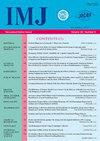JANUS KINASE INHIBITORS IN DERMATOLOGY: PRESENT AND FUTURE
Q4 Medicine
引用次数: 0
Abstract
New facts about the importance of the JAK−STAT signaling system in development of a number of inflammatory and autoimmune diseases are now emerging. The JAK−STAT system, or pathway consisting of Janus kinase (JAK) and signal transducer protein as well as transcription activator (STAT), transmits information from extracellular polypeptide signals through transmembrane receptors directly to target gene promoters in the nucleus without the involvement of secondary messengers. The JAK−STAT system plays an important role in the implementation of immunological processes and is considered a therapeutic target in immune−mediated inflammatory diseases. JAK inhibitors are so−called yakinibs, low molecular weight chemically synthesized targeted drugs that inhibit intracellular JAK signaling molecules and interrupt the effect of interleukins on the cell. Drugs have an acceptable benefit−risk ratio. The most common side effects are infections of the upper respiratory tract, urinary tract and gastrointestinal tract. The safety profile of topical JAK inhibitors is better than that of oral drugs due to their minimal systemic absorption. For the first time, JAK inhibitors have been shown to be effective in rheumatoid arthritis and myelofibrosis. Disordered regulation of the JAK−STAT signaling pathway is observed in various inflammatory and autoimmune skin diseases. JAK molecules are overexpressed in epidermis, dermis in psoriasis, atopic dermatitis, alopecia areata and vitiligo. Decoding the new mechanisms of pathogenesis of psoriasis, atopic dermatitis, alopecia areata, vitiligo created the preconditions for improving their pharmacotherapy with the use of inhibitors of Janus kinases. Today, JAK inhibitors are the most promising specific target agents when treating the immune−mediated dermatoses. Key words: JAK−STAT system, Janus kinase inhibitors, psoriasis, atopic dermatitis, alopecia areata, vitiligo.JANUS激酶抑制剂在皮肤病学中的应用现状与展望
关于JAK−STAT信号系统在许多炎症和自身免疫性疾病发展中的重要性的新事实正在出现。JAK−STAT系统,或由Janus激酶(JAK)和信号转导蛋白以及转录激活剂(STAT)组成的通路,通过跨膜受体将细胞外多肽信号中的信息直接传递给细胞核中的靶基因启动子,而不涉及次级信使。JAK−STAT系统在免疫过程的实施中发挥着重要作用,被认为是免疫介导的炎症性疾病的治疗靶点。JAK抑制剂是一种低分子量化学合成的靶向药物,可抑制细胞内JAK信号分子并阻断白细胞介素对细胞的作用。药物具有可接受的收益风险比。最常见的副作用是上呼吸道、泌尿道和胃肠道感染。局部JAK抑制剂的安全性优于口服药物,因为它们的全身吸收最小。JAK抑制剂首次被证明对类风湿性关节炎和骨髓纤维化有效。在各种炎症性和自身免疫性皮肤病中观察到JAK−STAT信号通路的无序调节。JAK分子在银屑病、特应性皮炎、斑秃和白癜风的表皮、真皮中过表达。解读银屑病、特应性皮炎、斑秃、白癜风的新发病机制,为使用Janus激酶抑制剂改善其药物治疗创造了先决条件。目前,JAK抑制剂是治疗免疫介导的皮肤病最有前途的特异性靶向药物。关键词:JAK−STAT系统,Janus激酶抑制剂,银屑病,特应性皮炎,斑秃,白癜风。
本文章由计算机程序翻译,如有差异,请以英文原文为准。
求助全文
约1分钟内获得全文
求助全文
来源期刊

International Medical Journal
医学-医学:内科
自引率
0.00%
发文量
21
审稿时长
4-8 weeks
期刊介绍:
The International Medical Journal is intended to provide a multidisciplinary forum for the exchange of ideas and information among professionals concerned with medicine and related disciplines in the world. It is recognized that many other disciplines have an important contribution to make in furthering knowledge of the physical life and mental life and the Editors welcome relevant contributions from them.
The Editors and Publishers wish to encourage a dialogue among the experts from different countries whose diverse cultures afford interesting and challenging alternatives to existing theories and practices. Priority will therefore be given to articles which are oriented to an international perspective. The journal will publish reviews of high quality on contemporary issues, significant clinical studies, and conceptual contributions, as well as serve in the rapid dissemination of important and relevant research findings.
The International Medical Journal (IMJ) was first established in 1994.
 求助内容:
求助内容: 应助结果提醒方式:
应助结果提醒方式:


